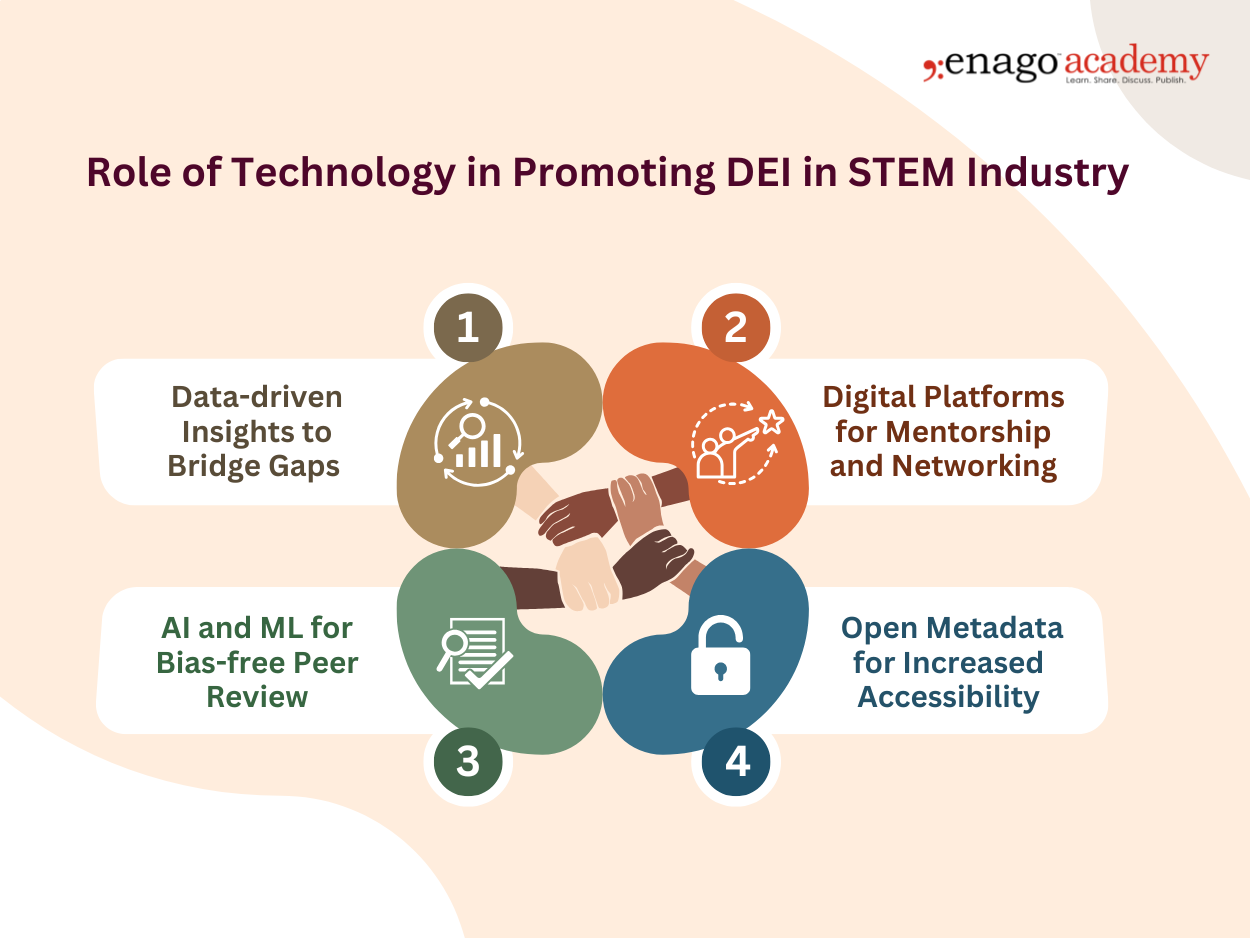Role of Technology in Promoting Diversity, Equity, and Inclusivity

Diversity, equity, and inclusion (DEI) are more than just buzzwords — they are the foundational principles that underpin the thriving and innovative STEM industry. Yet, there has been a longstanding gap in embracing DEI in its truest sense. For instance, only 34 % of global researchers are women. This issue is compounded by stark gender pay disparities. Men in STEM earn approximately $15,000 more annually than women, with non-Hispanic women facing even greater inequities, earning up to $33,000 less than their male counterparts.
 This acknowledgement highlights the historical lack of DEI in STEM fields, which has created a narrow and often exclusive landscape, limiting the perspectives, experiences, and contributions of underrepresented groups. This lack of diversity not only raises ethical concerns but also hinders scientific progress and innovation. Fostering DEI in STEM fields helps create an inclusive environment, drives innovative solutions, and ultimately ensures that science serves everybody equitably.
This acknowledgement highlights the historical lack of DEI in STEM fields, which has created a narrow and often exclusive landscape, limiting the perspectives, experiences, and contributions of underrepresented groups. This lack of diversity not only raises ethical concerns but also hinders scientific progress and innovation. Fostering DEI in STEM fields helps create an inclusive environment, drives innovative solutions, and ultimately ensures that science serves everybody equitably.
How can Technology Foster DEI in STEM Field?
Technology has increasingly become a powerful tool in driving positive change in advancing DEI in STEM. It promises to bridge gaps and empower underrepresented stakeholders in innovative ways to promote DEI. Here are a few ways in which technology is fostering this transformation:
Data-Driven Insights to Bridge Gaps
Robust technologies like large-scale data analytics can identify gaps in diversity among the various stakeholders of the STEM publishing industry. By tracking trends in funding, publications, and representation, institutions can understand systemic inequities and make data-driven decisions to prioritize inclusivity.
For instance, a NiH Reporter highlighted a huge disparity in funds allocated to Japanese researchers under grants awarded to projects in “foreign” (non-USA) countries. Out of the 1,432 projects funded with around $624 million, not a single grant was allocated to Japanese researchers. Similar demographic analysis of grant recipients helps uncover biases in funding distribution, consequently promoting more equitable resource allocation. These data-driven strategies empower stakeholders to measure progress, adapt policies, and foster inclusivity, ultimately ensuring equitable opportunities for all.
Digital Platforms for Mentorship and Networking
It’s now easier than ever to connect with others in STEM, thanks to technology. Dedicated platforms like Research Gate engages over 25 million scientists and science enthusiasts, enabling them to discuss and share their scientific viewpoints. On the other hand, social media platforms like LinkedIn connects over 1 billion professionals spread over 200 countries and regions across the globe. These advances have opened doors for underrepresented groups to network with mentors and industry leaders worldwide.
These platforms allow researchers from diverse backgrounds to share their work, gain recognition, and tap into valuable mentorship opportunities. Accessible virtual environments break geographical and financial barriers, building a more diverse pipeline for researchers and STM professionals.
AI and ML for Bias-free Peer Review
The peer-review process has long been criticized for its biases including those based on gender, race, affiliation, and other factors. Artificial intelligence (AI) and machine learning (ML) can complement innovative peer-review models to reduce biases in the peer-review process, ensuring fair evaluation of manuscripts. Robust algorithms minimize unconscious bias and promote objectivity, advancing DEI in the academic publication industry.
AI shows promise in improving DEI in STEM publishing industry beyond enhancing peer-review. Funding agencies in North America, and Europe have used simple AI tools to identify grant reviewers as it potentially reduces the time and inherent biases in the process. Going one step ahead, National Natural Science Foundation of China (NSFC) has built a more sophisticated system to help identify reviewers who could screen through the large volume of grant applications they get every year.
In an interview, Li Jinghai, the head of NSFC said, “Scientists try to lobby for their projects. A problem with evaluations is that people use connections. AI can’t be corrupted”
Open Metadata for Increased Accessibility
Open Metadata plays a critical role in ensuring that research is visible and accessible. By tagging research articles with inclusive, comprehensive and inclusive metadata, platforms enhance visibility for underrepresented groups and research areas.
For instance, the Global Equitable Membership (GEM) Program aimed at underrepresented regions like Bangladesh, Nepal, Ghana, and Tanzania have seen a significant increase in the Cross-ref’s membership base. This has strengthened its open digital infrastructure improving open scholarly communications.
At this juncture, it is important to note that this shift toward open science not only promotes inclusivity but also accelerates innovation by ensuring that research is available to a broader, more diverse audience.
Is Technology the Perfect Solution to Advance DEI in STM?
“To improve is to change; to be perfect is to change often.” -Winston Churchill.
While technology plays a crucial role in advancing DEI, there is a significant room for improvement. A major challenge is the lack of digital infrastructure in certain regions, limiting access to advanced tools and networking platforms. This disparity affects the participation of researchers from underrepresented communities.
In addition, inequitable access to resources like open-access journals or funding for technology further exacerbates this issue. AI and ML systems come with their own set of limitations. If AI training sets are not managed carefully, they can perpetuate existing biases, undermining efforts to foster fairness and inclusivity. Moreover, the underrepresentation of diverse voices in tech development teams means solutions may not fully account for all demographics, potentially reinforcing exclusion.
Despite these hurdles, technology has immense potential to ensure DEI in STM industry. Cautious and extensive use of AI, ML, and open metadata across different stages of the publication process —research design, conduct, validation, submission, peer-review, publication, access, and networking promises to build a more inclusive industry in future.











Great!